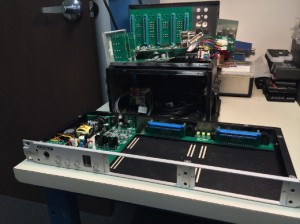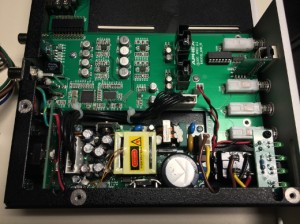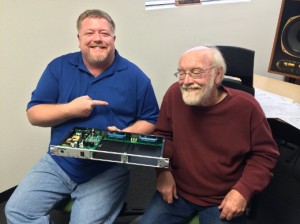Research & Development: Aphex D 500 DUO — 500 Series Rack with Analog & Digital I/O
When does 500 + 500 equal more than 1,000?
That was the tantalizing equation that the Aphex engineering team sized up when they dreamed up the D 500 DUO, the California gear gurus’ new two-slot 500 series receiving frame.
We first got interested in the DUO when we saw it in person at NAMM 2014. This was a rack designed to do much more than just plug in your units and hold them upright: The D 500 DUO is equipped with analog and digital I/O, offering S/PDIF digital inputs and outputs going up to 192k. It also has heavy duty 880mA power supplies, chaining and stereo linking, balanced inserts, and word clock in/out, for $499 MAP (it hits the market in March/April).
With 500 modules proliferating in studios of every stripe, innovations in the equally essential racks that hold them are worth investigating. Jace Nuzback, Product Specialist for Aphex, explains the origins of the D 500 DUO in our latest edition of “Research & Development”.
Starting with an overview, how would you characterize the evolution of the overall market for 500 series gear?
For a format that started in the mid-’70’s I’m surprised it has taken so long to try and get all of the manufacturers on the same page as far as the basics go: pin configurations, power supply requirements, etc.
I think that API is doing a good job of trying to help with all of this by starting the VPR Alliance.
Why is the format proving popular?
I think because it is a “space saving” system by design. A 10-Slot receiving frame only takes up three racks spaces. Lunchboxes also make for a great mobile solution.
How are customer needs changing, and how has the landscape of available 500 units and racks changed in kind?
Beyond sound quality, I think the most important issue facing 500 series users is “compatibility.”
Makers of 500 series processors are designing products that require more milliamps of current than ever before. The problem is that most receiving frames simply don’t supply enough current to power these modules properly. Especially when multiples of these power hungry modules are installed in one receiving frame.
Previously modules were only drawing 130mA. Some of the new modules are drawing close to 300mA! So if your four modules draw 1200mA and your frame only provides 800mA, things don’t work properly. Many 500 series users don’t even realize that this is an issue. Especially those users who are just starting out with 500 series products.
This leads to people returning products, posting negative reviews, etc… The best thing we can do as manufacturers is to educate our customers and provide all of the information required to allow them to make educated decisions. Luckily, some new receiving frames are coming out that address this issue.
People have long known about Aphex for classic gear like the Aural Exciter with Big Bottom. How would you characterize the philosophy behind the gear that Aphex is making today?
Over the years Aphex has created products for broadcast, live sound, installation and the recording studio.
Currently Aphex is focusing on recording products. Last year we released three USB recording products: The Microphone X, IN2 and the USB 500 RACK. We also have eight 500 series modules in our lineup that include mic pres, EQs, compressors and more — beyond that we have rack-mounted channel strips, compressors, high performance headphone amplifiers and more.
The biggest challenge that faces Aphex is letting the world know that we have this incredible line of products.
How did that kind of thinking lead to the idea for the D 500 DUO? What was the inspiration behind it, and what made it a fit for the kind of offerings that Aphex is moving towards?
It’s actually kind of funny — Aphex had a great 2-channel, rack-mounted preamp called the 207D. Not only was it a great sounding preamp, it also had inserts for each channel and built-in A/D with S/PDIF and AES/EBU digital outputs.
Not long after we discontinued the 207D, we ran in to some installation customers that had been planning on using MANY 207D units in a new facility. The analog inserts and digital outputs were big selling points for them.
As we had some great 500 series mic pres, it made sense to me to create a similar product but with two 500 series slots instead of built-in mic pres. It also seemed like the perfect companion product to our new Project 500 module! Project 500 is a full channel strip with Class A mic pre, optical compressor and two bands of overlapping EQ in a single module.
Combining two Project 500 modules with this new frame product seemed to provide a great solution for many applications. It also seemed like a great way to expand our already popular USB 500 RACK with the S/PDIF connection.
As you set out to design it, what challenges and surprises started to arise in realizing your vision?
The D 500 DUO is the kind of product that Aphex can knock out really quickly! Our Head Engineer, Gary Liden, and I laid out the signal flow diagram and feature set over a couple of days.
Aphex General Manager, Jim Bailey, came up with the idea of adding the S/PDIF “input” to the feature set. This made all of the sense in the world. One of the big features of our USB 500 RACK product is using modules as hardware inserts for DAW tracks and busses. The S/PDIF input would allow users of DAWs and digital consoles to do the same thing with two modules and the D 500 DUO.
From there, please describe the major stages of the design process – what had to happen to move the D 500 DUO from idea, to prototype, to the finished product?
At the moment the D 500 DUO is still in the prototype stage. We showed the very first prototype units at NAMM 2014. We hope to have it shipping in March or April.
Did any one of those stages prove especially difficult or complex to complete? Why?
Adding the S/PDIF input required us to add some things to the design, clocking, displays, buttons, etc… Nothing especially difficult, just changes.
The DUO seems to offer a lot more than just power – it includes S/PDIF digital inputs and outputs going up to 192k, 880mA power supplies, chaining and stereo linking, balanced inserts, and word clock in/out. How did you zero in on these features for inclusion?
We wanted the D 500 DUO to be at home in professional environments. So we knew 192kHz performance would be a must.
Professional environments often use a master word clock generator, so it had to lock to incoming clock via BNC. Balanced inserts seemed like a nice plus for a unit like this.
Other features, like chaining and stereo linking, were things that we were already doing with our UBS 500 RACK product. In fact, we use the same power supply from the USB 500 RACK in the D 500 DUO.
You also told me that Aphex can go from concept to completion very quickly with a product. Why is that?
Aphex is a very small company, but has a very experienced team with manufacturing here in Southern California. Our head engineer, Gary Liden, has been with Aphex since the 80’s! Our head of manufacturing, Raymond Lui, also has a very long history with Aphex. After making products together for so many years, the process just gets faster and faster.
Charlie Boehm, Jim Bailey and I have all helped design products for TASCAM, M-Audio, AVID and Line 6. Jim Bailey and I are musicians as well as recording engineers too. We all work together extremely well. The simple fact that we are so small and don’t have to get approval from dozens of people to do every little thing really helps us move fast.
So in a working studio, how do you see the DUO not just housing/powering 500 units, but also evolving/transforming workflow, and benefitting the finished sonic product?
I think the D 500 DUO makes it easier and more affordable to bring high quality analog processing to our digital recording world. It brings the ability of using analog hardware inserts to anyone that has an audio interface with S/PDIF I/O.
It also makes an impressive addition to the USB 500 RACK product. With a simple S/PDIF cable, you can record with two more mic pres or process with two more compressors, etc.
Finally, what’s The Big Lesson you learned from creating the DUO? How will that help you and your team with the next piece of gear you design?
You always learn something new with every new product you bring to market. With the D 500 DUO, it was things like learning to program with new chip sets, buying different parts from different suppliers with different lead times, etc…
All of those things make a difference in how fast you can bring a product to market.
Thanks Jace! Anything else?
Check out our 500 series modules! We get a lot of attention for our innovative frames like the USB 500 RACK and the D 500 DUO, but our modules are extremely good and really deserve the same attention!
— Jace Nuzback, Product Specialist, Aphex









